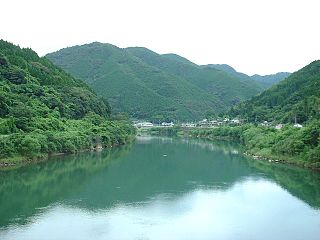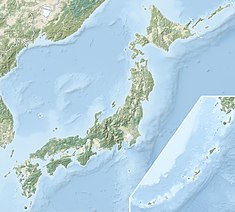
Ena is a city located in Gifu, Japan. As of 1 June 2019, the city had an estimated population of 48,777, and a population density of 96.7 persons per km², in 19,820 households. The total area of the city was 504.24 square kilometres (194.69 sq mi).

Akiyama Nobutomo was a samurai during the Sengoku period in Japan. He is known as one of the "Twenty-Four Generals of Takeda Shingen". Nobutomo also served under Shingen's son, Takeda Katsuyori.

Iwamura was a town located in Ena District, Gifu Prefecture, Japan.
ALGOL N is the name of a successor programming language to ALGOL 60, designed in Japan with the goal of being as simple as ALGOL 60 but as powerful as ALGOL 68. The language was proposed by Nobuo Yoneda. ALGOL N tried to use extensibility to solve the problem that language designers faced when trying to make an inextensible language for all domains, or having to make many domain-specific languages (DSLs), one for each domain. It avoided type conversion (coercion) while not making things more difficult for programmers.

Iwamura Castle was located in the southeastern area of Mino Province in Japan. Its ruins can be found in the modern-day municipal subdivision of Iwamura, in Ena, Gifu Prefecture. Along with Takatori Castle in Nara and Bitchu-Matsuyama Castle in Okayama, it is regarded as one of the three best mountain castles, and at an elevation of 721 meters above sea level, it is one of the highest in Japan.

The Kuma River is a river in Kumamoto Prefecture, central Western part of Kyūshū, Japan. It is sometimes referred as Kumagawa River. It is the longest river in Kyushu, with the length of 115 km long and has a drainage area of 1,880 km2 (730 sq mi). The tidal flat of the Kuma River estuary is approximately 1000 hectares.

An AV idol, also known as adult video idol or AV actress, is a Japanese idol who works in the pornographic business, often both as an actress as well as a model as the video performances vary widely, from suggestive softcore imagery to hardcore pornography. The industry is noted for having frequent turnovers; since the dawn of the AV industry in the early 1980s, hundreds of AV idols have debuted every year, with an average career span of about a year, appearing in five or ten videos during that time. Few notable AV idols have careers spanning longer than a decade, have a wide general public recognition, or make a significant impact on the industry in some other manner.
The siege of Iwamura was a military event which occurred in 1572 in Japan, concurrent with Takeda Shingen's push into Tōtōmi Province and the Battle of Mikatagahara.

Tōnō (東濃) is the southeastern portion of Gifu Prefecture in the Chūbu region of Japan. The Tōnō region received its name as a combination of the kanji for "east" (東) and "Mino" (美濃). The borders of this region are not officially set, but it generally consists of the following cities: Tajimi, Toki, Mizunami, Ena and Nakatsugawa. Occasionally, Kani, usually part of the Chūnō region, is also included as being part of Tōnō.

Battle in Outer Space is a 1959 Japanese science fiction film directed by Ishirō Honda, with special effects by Eiji Tsuburaya.
Ai Iwamura, also known as Aiko Iwamura is a Japanese actress, born on March 4, 1984.

Akinori Iwamura is a former Japanese baseball infielder, who currently is a manager for the Fukushima Red Hopes in Japan's Baseball Challenge League. He made his Major League debut with the Tampa Bay Devil Rays in 2007.

Iwamura Station is a train station in the city of Ena, Gifu Prefecture, Japan, operated by the Third-sector railway operator Akechi Railway.

Agigawa Dam is a dam built on the Kiso River system, located in the Higashino section of Ena City, in Gifu Prefecture, Japan.

Championship Round of the 2009 World Baseball Classic was held at Dodger Stadium, Los Angeles, California, United States, from March 21 to 23, 2009.

JTE 7-31 is a selective cannabinoid receptor agonist invented by Japan Tobacco. It is a reasonably highly selective CB2 agonist, but still retains appreciable affinity at CB1, with a Ki of 0.088nM at CB2 vs 11nM at CB1.

Hiizu Iwamura is a Japanese chemist and Professor of Chemistry, Nihon University, as well as Professor Emeriti of the Institute for Molecular Science in Okazaki, the University of Tokyo, and Kyushu University in Japan.
Lady Otsuya was a Japanese female samurai (onna-musha) from the Sengoku period. She was the aunt of the famous samurai Oda Nobunaga, the wife of Tōyama Kagetō and foster mother of Oda Katsunaga. She was the ruler of Iwamura Castle until the last days of her life.

Iwamura Domain was a feudal domain under the Tokugawa shogunate of Edo period Japan, located in Mino Province in what is now the town of Iwamura, Gifu. It was centered around Iwamura Castle, and controlled parts of Mino and Suruga Provinces. Iwamura Domain was controlled by a number of fudai daimyō clans in the course of its history.














